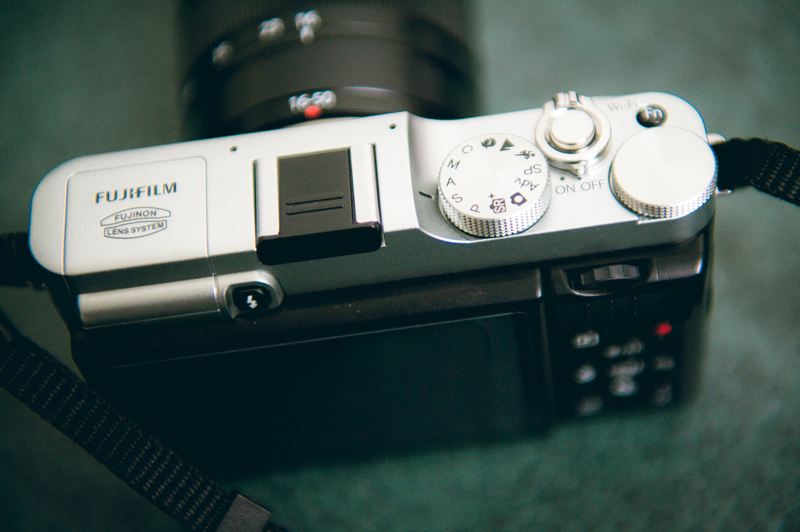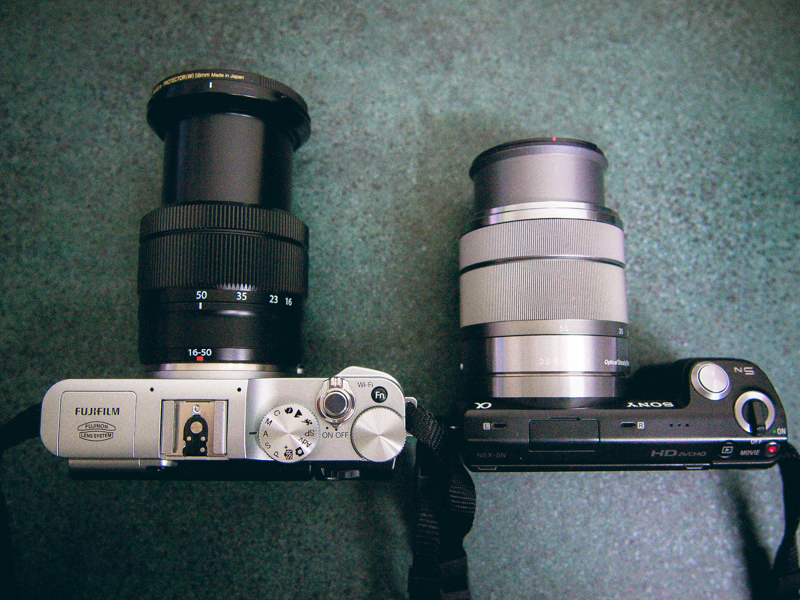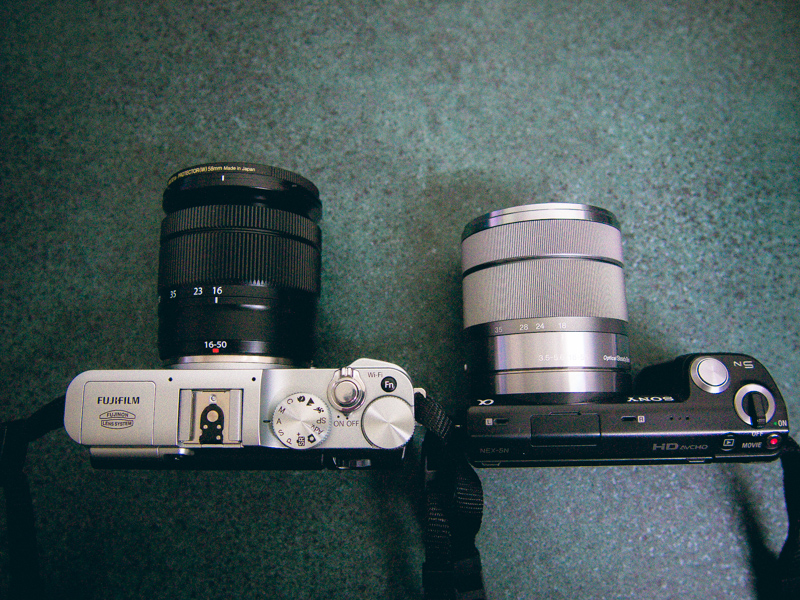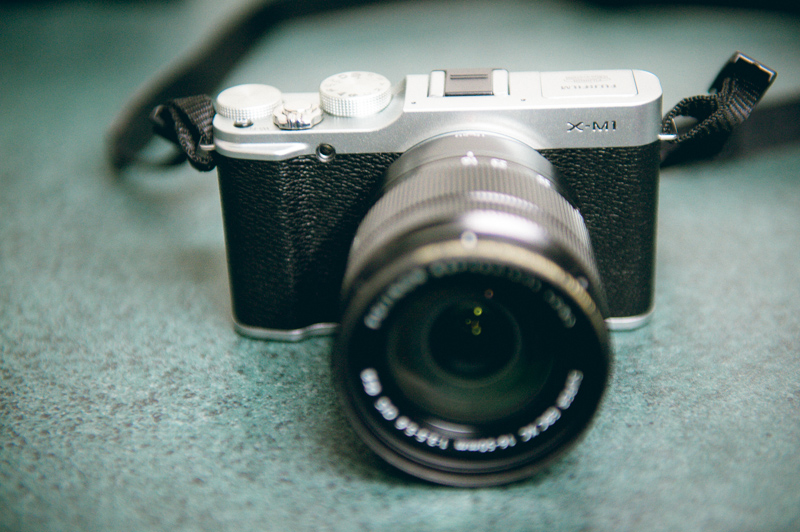If you like this post, help us share it
It has been a year and eight months since the introduction of the popular X-Pro 1. Since then, the Fujifilm has added an enthusiast-orientated X-E1 and now the more amateur-orientated X-M1. The “M” suppose to stand for Mini, which is the exact description of this camera. The X-M1 is much smaller in size than its two high end siblings. Unlike the X-Pro 1 and X-E1, the X-M1 has no OVF or EVF, instead it uses a nice 3” 921K dot articulate LCD. The X-M1 comes with a new kit lens XC 16-50mm f/3.5-5.6 OIS, which has the same stunning optic quality but housed in a plastic barrel. Along with the removal of the aperture ring, this keeps the cost of the lens down.
At first, I was a bit worry on the build quality of the X-M1 and kit lens. Knowing that the lens is made from plastic and the top and bottom plates of the camera are also made from plastic. I was a bit skeptic at first but once I have my hands on it, it actually felt very well made. While the top and bottom plates are made from plastic, the finish is very good. It is not with the same build quality of the X-PRO 1 but it doesn’t feel cheap either. I would say it is similar build quality to any entry level DSLR.
The X-M1 comes in three colours, you can order them via B&H. (Black | Silver | Tan)

The X-M1 no longer has the shutter speed dial at the top instead it replaces with a mode dial that is more familiar with amateurs. The second top dial act as an exposure compensation dial or shutter speed dial in M mode. This dial makes the operation of the camera very snappy. The sub dial which is at the back is now orientated upwards, some people have been saying it is in a strange orientation but I didn’t feel too bad about it. There is also a Fn button at the top which is customisable. On the other side of the top plate host the pop up flash which Fujifilm claims it is super intelligent and will not overly expose your subject. I did a couple of quick tests putting my hand in front of the camera and it seems to be the case. The button layout of the X-M1 is simple, the buttons are not over crowded or too fiddly to use. It is great to see the X-M1 offers twin dials which many cameras don’t. The menu system itself is a simple one, all the functions are there at the first level of the menu.


Like any other mirrorless cameras, the X-M1 has a Q menu which hosts most of the useful settings like AF modes, ISO and image quality settings, but surprisingly flash compensation and metering modes are not in there. Instead the X-M1 focuses a lot on the output setting for JPG image, the quick menu has access to film simulation, image sharpness, dynamic range (DR), highlight and shadow settings. It is almost saying this camera is great for JPG. There is no doubt one of the great features of the Fujifilm X cameras is their film simulation mode. It produces stunning images straight out of the camera if you use it correctly.

In terms of size, the X-M1 is not the most compact APS-C camera, comparing to the NEX system, the body and lens are slightly bigger and heavier but still very comfortable to use. I find the buttons on the NEX-5 system are actually too small to handle. It is quite interesting to see that the new Sony 16-50mm lens is much smaller than the Fuijifilm’s one, but Fujifilm lenses are known for their superb optic quality. The Fujifilm 16-50mm is constructed with 12 elements in 10 groups, including 3 aspherical lenses and 1 extra low dispersion element, whereas the Sony 16-50mm is constructed with 9 elements in 8 groups, including 1 extra low dispersion and 4 aspheric elements.


The first impression of the X-M1 is pretty good, the build quality is on par with any entry level DSLRs, the general handling of the camera is very well, especially via the twin dials. The X-M1 is however not without any flaws, I have noticed some already. I will be spending some time with the camera over the next few weeks, taking it to a couple of photo assignments and a bit of travelling use. So watch this space for a detail hands on review of the camera, including image samples taken from the X-M1 as well.

X-M1 full specification
| Lens Mount | Fujifilm X Mount |
| Camera Format | APS-C (1.5x Crop Factor) |
| Pixels | Actual: 16.5 Megapixel Effective: 16.3 Megapixel |
| Max Resolution | 4896 x 3264 @ 3:2 |
| Other Resolutions | 3456 x 2304 @ 3:2 2496 x 1664 @ 3:2 4896 x 2760 @ 16:9 3456 x 1944 @ 16:9 2496 x 1408 @ 16:9 3264 x 3264 @ 1:1 2304 x 2304 @ 1:1 1664 x 1664 @ 1:1 |
| Sensor Type / Size | CMOS, 23.6 x 15.6 mm |
| File Formats | Still Images: JPEG, RAW Movies: H.264, MOV Audio: Linear PCM (Stereo) |
| Dust Reduction System | Yes |
| Noise Reduction | Yes |
| Memory Card Type | SD SDHC SDXC |
| Video Recording | Yes, NTSC/PAL |
| Resolution | 1920 x 1080: 30 fps 1280 x 720: 30 fps |
| Aspect Ratio | 16:9 |
| Video Clip Length | Up to 27 Min |
| Audio Recording | Built-in Mic: With Video, Stereo, |
| Focus Type | Auto & Manual |
| Focus Mode | Single-servo AF (S), Continuous-servo AF (C), Manual Focus (M) |
| Autofocus Points | 49 |
| Display Screen | 3" Rear Screen Tilting Live Preview LCD (920,000) |
| Screen Coverage | 100% |
| Live View | Yes |
| ISO Sensitivity | Auto, 200-6400 (Extended Mode: 100-25600) |
| Shutter | Type: Mechanical Speed: 30 – 1/4000 sec 1/4 – 1/4000 sec in Auto Mode |
| Remote Control | RR-90 (Optional) |
| Metering Method | Average metering, Multi-zone metering, Spot metering |
| Exposure Modes | Modes: Aperture Priority, Manual, Programmed Auto, Shutter Priority Compensation: -2 EV to +2 EV (in 1/3 EV steps) |
| White Balance Modes | Auto, Custom, Fine, Fluorescent (Day White), Fluorescent (Natural White), Fluorescent (White), Incandescent, Shade |
| Burst Rate | Up to 5.6 fps at 16.3 MP for up to 30 frames |
| Flash Modes | Auto Auto/Red-eye Reduction Flash On w/ Red-eye Reduction Forced On Rear Curtain/Slow Sync Slow Sync Slow Sync./Red-eye Reduction |
| Built-in Flash | Yes |
| Guide No. | 22.97′ (7 m) ISO200 |
| Max Sync Speed | 1 / 180 sec |
| Dedicated Flash System | iTTL |
| External Flash Connection | Hot Shoe |
| In-Camera Image Editing | High Key, Low Key, Miniature Effect, Pop Art, Soft Focus, Toy Camera |
| Start-up Time | 0.5 Seconds |
| Continuous Shooting | Up to 5.6 fps |
| Self Timer | 2 sec, 10 sec |
| Date & Time Stamp | Yes |
| Connectivity | HDMI C (Mini) USB 2.0 |
| Wi-Fi Capable | Yes |
| Battery | 1x NP-W126 Rechargeable Lithium-Ion Battery Pack |
| Operating/Storage Temperature | Operating 32 to 104°F (0 to 40°C) Humidity: 10 – 80% |
| Dimensions (WxHxD) | 4.6 x 2.6 x 1.5" / 11.7 x 6.6 x 3.8 cm |
| Weight | 9.88 oz / 280 g without battery and card |
| Focal Length | 16 – 50 mm Comparable 35mm Focal Length: 24 – 76 mm |
| Aperture | Maximum: f/3.5 – 5.6 Minimum: f/22 |
| Angle of View | 83° 2′ – 31° 7′ |
| Minimum Focus Distance | 23.62" (60 cm) |
| Magnification | 0.15x |
| Groups/Elements | 10/12 |
| Diaphragm Blades | 7 |
| Autofocus | Yes |
| Image Stabilization | Yes |
| Filter Thread | Front: 58 mm |
| Dimensions (DxL) | Approx. 2.46 x 2.57" (62.6 x 65.2 mm) |
| Weight | 6.88 oz (195 g) |
Where can I find the equipment seen on this site?
If you find this site useful and planning to purchase any of the equipment seen on this site, please show your support by purchasing your photo equipment at B&H Photo Video, or through any of the affiliate links seen on this site.

